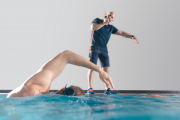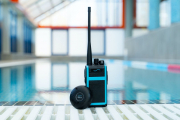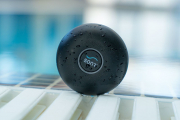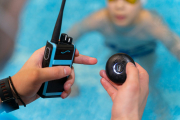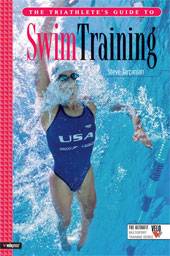As a triathlon coach, I want to be able to help my athletes improve technique in the water. Watching from the deck as an athlete swims, I can often identify a flaw in technique that could easily be improved with a cue (while they are swimming). Sometimes I can catch their attention from the side of the pool when they turn their head to breathe and, with some wild gesture, impart some information that will cue them to correct their technique. Often, they don’t understand what I’m waving about and everyone else on deck gets a little comedy show watching me.
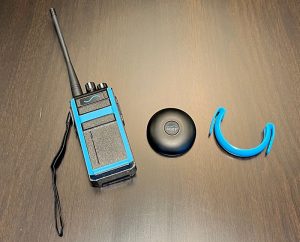
Enter the SONR “coach communicator,” which offers swim and triathlon coaches the opportunity to talk to athletes while the athletes are swimming. The system is pretty simple: a walkie-talkie transmitter that the coach speaks into on deck and a set of bone-conduction pucks (SONR receivers) that are worn by swimmers under their caps or attached to goggle straps.
The receiver units themselves are small — somewhat underwhelming given the job they do. The swimmers wear the SONR receivers, which are about 2.5 inches in diameter and about a half inch thick, anywhere on their heads. The coach talks into the walkie-talkie and the swimmers can hear the coach. It’s really that simple. Coaches can provide real-time feedback, correction, and pacing information — and the swimmers can’t talk back!
I recently had the opportunity to test the SONR system with some swimmers (and on myself). To put it simply, it works exactly as advertised. My swimmers could hear me whenever I spoke — regardless of whether they were at the surface, under water, doing a flipturn, or at the far end of the pool.
SONR claims a receiving distance of 300 meters when the swimmer is at the surface and 50 meters when the swimmer is a meter below the surface. We didn’t get a chance to test the reception limits of the device, but it worked fine across a 25-yard pool, even when swimmers were underwater.
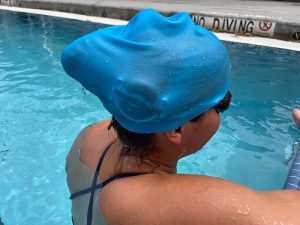
The walkie-talkie transmitter unit has six channels that can be customized to work with up to 30 receivers. One channel communicates with all swimmers who are wearing a SONR receiver and the other channels can be customized to communicate with specific individual swimmers or groups of swimmers (such as everyone in the same lane). In the test set that was loaned to me by SONR, there was only one receiver, so I was unable to test communication with groups; however, it’s easy to imagine how well that would work.
The SONR receiver initially required a bit of fussing to get it in the right spot on our heads. But once it was in place, it was more or less unnoticeable. The little puck can be tucked under a cap or attached to goggle straps using a small cradle-like clip. We found placement on the back of the swimmer’s head or on the swimmer’s temple to be the best spots. The “volume” was slightly better when the receiver was on the temple. Note that there is no volume control. To “increase volume,” the coach needs to talk louder into the transmitter. When swimming at a harder effort, it was harder to hear the coach, but wearing a cap and earplugs made hearing easier.
If you’ve never used a bone-conduction device for listening to sound, it’s a bit hard to explain the sensation. In short, our brains seemed to adjust quickly to “hearing,” even though the sound wasn’t coming through our ears. The first few seconds were a bit unusual — we were just aware of the sounds even though we weren’t “hearing” anything. But after that, it was more or less like listening through headphones.
The walkie-talkie transmitter comes with a charging cradle and the SONR receivers are charged with a magnetic USB cable. We didn’t push the extremes of time but SONR claims 90 minutes of talk time and up to three hours of mixed usage. This is more than enough for most coached workouts.
A basic set (one transmitter and one receiver) sells for $249. Individual receivers sell for $199 and transmitters for $49. SONR offers packages that slightly reduce the cost if you’re buying a bigger system (e.g., a “team set” of one transmitter and eight receivers for $1,539).
Overall, I’m impressed by the way the system works. It’s hard to say much more about a product that does exactly what it claims to do. Having the ability to work on technique or pacing in real time is a super valuable tool that I would expect to lead to faster progress in developing technique for every level of swimmer.
SONR loaned equipment for testing and the equipment was returned after the testing for this review was complete.

